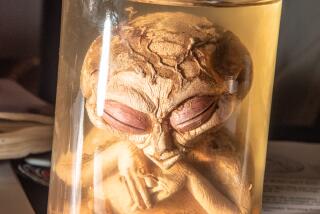Undaunted by Skepticism : Cold Fusion Is Still Hot Stuff in Defensive Utah
- Share via
SALT LAKE CITY — He looks a bit like Chevy Chase, sounds not unlike folk-rocker Dan Fogelberg and describes his latest songs as “tech-rock.” With titles like “Don’t Go Touchin’ My Electrode,” who’s to argue?
Brian Jackson Fetzer, college math instructor by day, aspiring singer by night, has found artistic inspiration--and a buck or two--in cold fusion.
Forget that many esteemed scientists around the world have pooh-poohed the stunning announcement made in March that a University of Utah chemist and his British partner had produced fusion energy in a flask at room temperature. Forget that skeptics are crooning the dirge of cold fusion.
In Utah, cold fusion lives.
State officials, concerned about Utah’s image but undaunted by the criticisms, have gone ahead and allocated $5 million for cold fusion and related patent research.
Entrepreneurs, meanwhile, are still peddling cold fusion T-shirts, baseball caps, mugs and bumper stickers, while radio disc jockeys are still spinning Fetzer’s tune, “Cool Fusion”:
I been playin’ with palladium,
Doodlin’ deuterium,
Saturatin’ hydrogen ,
Lettin’ off the oxygen .
Some people say it’s illusion ,
But we’re talkin’ ‘bout cooooool fusion .
The song may not be hit material, but it has a following: People here are doing aerobics to it.
Fetzer, who teaches at both the University of Utah (the “U,” as it is known) and Brigham Young University (the “Y”), 40 miles down the road in Provo, has sold a few hundred recordings of “Cool Fusion.” Business, he figures, will soar if the cold version proves true.
Utah appears to be doing as much as possible to make it happen.
This month, bolstered by state funds, graduate students began moving equipment into a vacant 25,000-square-foot building near the U campus. The awning over the front door may still be emblazoned with “ARUP,” the acronym of the pathologists’ association that last leased the place, but Utah officials already are trumpeting it as the “National Cold Fusion Institute.”
Grand Plan
There, with government funds and corporate grants, the finest scientists in the state are to work side-by-side with their counterparts from American corporations, perfecting cold fusion and developing its commercial applications.
That is the plan anyway. While more than a dozen major corporations have expressed interest in collaboration, none have taken out their checkbooks just yet and only one, General Electric, has even agreed to send research personnel to Utah.
Moreover, former NASA administrator James C. Fletcher, a native of Utah who initially indicated that he would return to his home state to direct the fight for cold fusion, has decided to stay in Washington and lead the fight from there.
Enthusiasm nonetheless springs eternal on the banks of the Great Salt Lake.
“It may not be a diamond,” Fetzer says of the controversial findings announced in March by U chemist B. Stanley Pons and his British colleague, Martin Fleischmann, “but at least it’s interesting cut glass.”
It is an attitude that seems to typify common sentiment around here, despite allegations raised by scientists elsewhere that cold fusion, at least at this stage of research, is all so much folly.
“I’m not going to worry about being embarrassed if it doesn’t turn out,” said Utah Gov. Norman H. Bangerter. “If it’s successful, it will do a lot for Utah. But what it will mean to Utah will be secondary to what it means to the world.”
Scientists have spent more than 30 years and billions of dollars trying to sustain nuclear fusion, the same process that fires the sun. Their goal has been to employ elements such as deuterium, found in seawater, and fuse their atoms to provide mankind with a clean and inexhaustible replacement for oil and other polluting fossil fuels.
The problem has been that during experiments, researchers have had to heat materials to millions of degrees--hotter than the core of the sun--to sustain fusion energy. The amount of energy expended during these experiments, in which atoms are fused to create heat, has been more than the amount produced.
So the scientific world was floored when Pons and Fleischmann announced that they had sustained fusion energy using an ordinary flask and an electrode--stuff that can be found in any freshman laboratory.
As the two chemists explained it, they simply filled the flask with some deuterium oxide, a form of “heavy water,” inserted an electrode cylinder made of palladium wrapped in platinum and ran an electrical current through the apparatus. The result, they said, was net energy--and lots of it.
Chemists and physicists around the world hurried off to their own labs to duplicate the experiment. Baking a souffle would have seemed more challenging.
The souffle, in most cases, flopped. A few scientists reported fusion reactions but none to the degree or consistency claimed by Pons and Fleischmann.
Rejected by U.S.
“No conclusive evidence,” a U.S. Department of Energy panel stated in rejecting Utah’s funding requests for cold fusion research.
“Incompetence . . . perhaps delusional,” a Caltech physicist sniffed.
“Pie in the sky,” said a researcher at AT&T;’s Bell Laboratory in New Jersey.
“A mad idea,” a colleague at the British Atomic Energy Authority harrumphed.
Even University of Utah physicists in the last two weeks have reported finding no evidence of a nuclear reaction in their own cold fusion experiments.
As if all that were not hard enough to take, non-experts, including newspaper editorialists and stand-up comedians, have also gotten into the act.
“They say they have cold fusion in Utah,” satirist Mark Russell is fond of telling his audiences these days. “You can’t even get a cold beer in Utah.”
None of this, of course, has boosted self-image among the 1.7 million people who live in the Beehive State.
While Pons has lowered his profile amid the less-than-flattering critiques of his research (“He’s not giving interviews,” said his wife), other Utahans have grown openly defensive, contending that much of the country--even New Jersey--is looking down its collective nose at them and did so long before cold fusion became fodder for public debate.
When the Salt Lake City Tribune reprinted a New York Times editorial suggesting that cold fusion research funds would be “better spent on a horse,” Utahans seethed.
“Those Eastern schools and Eastern papers are showing their true stripes in their chorus of hootings and denigration and catcalls at our scientists, school and state in general,” one angry reader responded. “They’ll all no doubt be bitterly disappointed if indeed this cold fusion process becomes a reality.”
Not everyone here is as supportive. There are those who contend that cold fusion is simply the latest chapter in a state history punctuated by ballyhooed successes that ultimately fizzled.
Unflattering Events
Utah, after all, has played host to some of the nation’s biggest stock frauds and investment scams. It was no mere coincidence, they say, that a 1967 George C. Scott movie, “The Flim-Flam Man,” used Utah as its backdrop.
It is also the place where, in December, 1982, U surgeons implanted an artificial heart in a human being for the first time. The patient, a retired dentist named Barney Clark, survived 112 days; criticism from within the medical community that the Clark case was immoral experimentation has persisted much longer. Since Clark’s death, artificial hearts have had only limited use.
To be sure, there are glorious national parks in Utah, superb snow skiing, a surplus of affordable housing and the highest percentage of college graduates and postgraduates in any state.
There are also relatively restrictive drinking laws, the alleged domination of the Mormon church--about 60% of Utah’s population belongs--and a cultural environment in many areas that has been described as chauvinistic by some and xenophobic by others. Indeed, there are only 36 liquor stores in Utah, all of them state-run, and more than 20,000 practicing polygamists.
Thus, given what some would contend is a repressive image--not to mention an economy smarting from industrial declines in oil, copper and steel--many Utahans would like nothing better than to build their state into a mecca of high-tech, cold fusion development. A more progressive image, it is thought, could attract diverse industry and greater numbers of tourists, spawning an even bigger financial boon.
“Cold fusion could have a considerable impact,” agreed John Talmage, an analyst for the Utah Foundation, a private think tank that this month issued a research brief suggesting that Utahans themselves are largely to blame for projecting a “negative” view of their state.
Public Perception
“Some people go around picturing Utah as a big Amish community,” Talmage said, chuckling. “I think it’s safe to say we’re a little more mainstream than that.”
Even hip, as the case may be. Consider James J. Brophy, the U’s vice president for research and development, and Utah’s chief spokesman for cold fusion.
Right in the thick of the cold fusion controversy, he and his wife, Muriel, jetted off to Los Angeles last month to attend the wedding of Playboy magazine publisher Hugh M. Hefner and former Playmate centerfold Kimberly Conrad.
As it turns out, Brophy and Hefner are boyhood friends who grew up together in Chicago. Brophy was best man at Hefner’s first wedding; Hef was Brophy’s best man.
The academician from Utah gave the bon vivant from Holmby Hills a toaster for a wedding gift.
Meanwhile, back at the National Cold Fusion Institute, Hugo Rossi was busily trying to prepare the place for what he and other officials hope will be an onrush of scientific interest in coming months.
Rossi has gone on leave from his regular duties as dean of the U’s College of Science to oversee operations at the budding Cold Fusion Institute. Ultimately, it is hoped, more than 40 researchers will work there, monitoring anywhere from 30 to 100 electrically charged “cells” similar to the one with which Pons and Fleischmann created so much friction nearly six months ago.
Today, there are only four employees at the institute, including Rossi and his secretary.
“I’d like to say, ‘Have a cup of coffee,’ he told a visitor recently, “but we don’t even have a coffee maker. We don’t have anything yet.”
Not even Pons, the chemist who helped start the whole thing, can be found at the institute. Pons, according to Rossi, has decided to stay cloistered in his own basement lab on the U campus.
“Stan will have a presence and an office here,” Rossi said, “but he and Fleischmann are not really interested in the kind of programmatic research we intend to do. We want to find out if there is commercial viability in cold fusion. Stan and Martin are more interested in experimentation.”
The Cold Fusion Institute, Rossi said, has a two-year budget. But Rossi, a pragmatic, transplanted New Yorker, conceded that “we may not be here that long” if outside funding sources do not develop.
“Five million dollars is a drop in the bucket,” he said. “We need $25 million, $50 million to do this right.”
The big bucks may never come. The dreams of a cold fusion windfall in Utah may remain just that.
But whatever happens, singer Brian Fetzer is ready. He has already written the “Cool Fusion Blues”:
And where do the big brains go
When they need a shoulder to cry on?
Scientific liaison can sometimes be cruel
I got the cool fusion blues.
More to Read
The biggest entertainment stories
Get our big stories about Hollywood, film, television, music, arts, culture and more right in your inbox as soon as they publish.
You may occasionally receive promotional content from the Los Angeles Times.








